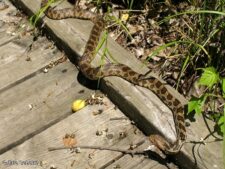
This large, native, non-venomous snake grows to 5 feet long. It is grayish-yellow with dark brown-black spots. The young have a dark line between the eyes and another backwards from the eyes to the angle of the jaw, as barely seen in the images (A,B). The snake depicted in images (C,D) was also identified as a Western Fox Snake, with the help of Michael Graziano, the University of Nebraska at Omaha. The Fox Snake is a constrictor, but it also vibrates its tail like a rattlesnake, to ward off enemies. It gives off a smell similar to that of a fox when threatened, reflecting its common name. The similar Brown Snake (Storeria dekayi) does not have the well-defined dark spots and the adults are much smaller.
The Western Fox Snake is rarely seen in our two nature centers. They are excellent swimmers and are most often found near water. But they also climb trees. Because they are cold-blooded, they hide below ground on hot days and hibernate during winter. Their eggs are up to 2 inches long; they hatch from August to October with hatchlings already up to 12 inches long.
There have recently been changes in this snake’s taxonomy. The Eastern and Western versions of this snake were considered sub-species of Elaphe vulpina, but are now two separate species, the Western Fox Snake with its new genus name Mintonius being the one present in our area.
The content of NatureSearch is provided by dedicated volunteer Naturalists of Fontenelle Forest who strive to provide the most accurate information available. Contributors of the images retain their copyrights. The point of contact for this page is: Roland Barth.




